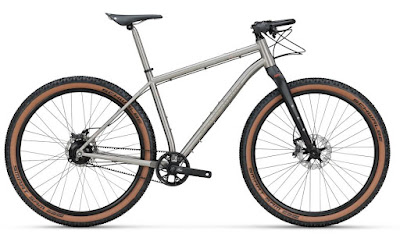This post will do something that, to my knowledge, few if any other pieces of writing have done: mention an early bicycle suspension system and a French ladies' utility bicycle from the 1960s or 1970s.
That wasn't my original intention, but in the admittedly-cursory research I did, the two topics became entangled.
How did I start on this path (pun intended)? Well, a few days ago I saw this
parked around the corner from my apartment.
At first glance, it looks like any number of French ladies' utility/city bikes of its time: The swept-down top lateral tubes lend it a grace most "beast" bikes don't have. That detail distinguihes somewhat from the mixte bikes that made their way to the US during the 1970s Bike Boom. Those bikes--like the Peugeot UO8 mixte--had straight twin lateral tubes. As a result, bikes like the U08 had slightly tighter geometry than bikes like the one in this post, which gave them a somewhat sprightlier ride.
You can still find plenty of bikes like the one in my photos parked on Paris streets and all over France: they were, and still are, for many French women what classic British three-speeds were for generations of women riding to work, the marketplace or the park in much of the Anglophone world.
But I knew, right away, something was odd about this bike. One give-away was the "Belle de Paris" decal on the downtube: I mean, if you saw that in a movie, you'd think it was a joke. No French bike maker would have given such a name to a bike it planned to sell in France--or to anyone who knows anything about French bikes!
(I think now of the car Renault sold as "Le Car" in the US. Even if you don't know or care about anything French, you just had to roll up your eyes on seeing that!)
Another odd thing about the bike is the brand name: Pierce-Arrow. As far as I know, there never was a French bike-maker by that name. And then there's this:
Some of the Motobecanes imported early in the US Bike Boom had fork crown caps stamped with the telltale "M" emblem. Also, some bikes made by Motobecane and sold under other names--like Astra--bore it.
And, of course, Motobecane made many bikes like this one: Of all French manufacturers, it's likely that only Peugeot made more. So, I surmised--correctly, my research would confirm--that I was looking at a Motobecane rebadged as "Pierce-Arrow".
So what of Pierce-Arrow?
Anyone who knows anything about the history of luxury automobiles knows the name. Heck, even I knew about them! Before World War II, they had a cache on par with the revered names of today like Rolls-Royce and Mercedes Benz. And, like most other auto manufacturers of the time--and a few that survive today (think of Peugeot and Ford)--Pierce-Arrow was a bicycle-maker before it manufactured cars (and, in Pierce's and Peugeot's case, motorcycles). And, in another interesting parallel with Peugeot, Pierce began as an industrial company that manufactured a variety of items (Yes, that peppermill was made by the same company that made the PX-10!) before venturing into wheeled goods.
George N. Pierce started his company in Buffalo, NY in 1872. In 1890, at the dawn of the first "Bike Boom," Pierce produced its first bicycles. They quickly developed a reputation for quality and elegance as well as elegance. As per the latter, the company offered one of the early "ladies'" models of safety bicycle, with a graceful tube that swept down from the head tube.
 |
| Seamless joint. From 1897 Pierce Bicycle catalogue. |
As for technical innovations, they contributed two that would influence later bicycle develpment. According to their 1897 catalogue, their frames had seamless joints achieved by "fittings inside one tube and shaped to fit snugly around the opposite tube." This can be seen as a predecessor of both lugged and fillet-brazed joints: the joining methods used to this day on most high-quality steel frames.
 |
| Pierce Cushion Frame, 1901 |
The other? One of the earliest frame suspension systems. In 1898, their Cushion Frame line featured a shock absorber on the post connecting the rear axle to the seat pillar. Hmm...I think I saw something like that on a few mountain bikes--in 1998, or thereabouts!
Anyway, Pierce continued to make bicycles until 1918, when the Emblem Manufacturing company in the nearby community of Angola acquired them. Emblem continued to produce bicycles until 1940--ironically, two years after Pierce-Arrow Motor Car Company ceased to exist.
Now, from what I've gleaned, the company's bicycles were never called Pierce-Arrow. That appelation was reserved for cars. Bicycles and motorcycles were always called "Pierce." The Pierce-Arrow name, however, would be conflated with Pierce bicycles--possibly because of the arrow in Pierce's emblem. In the years after the last Pierce bicycles were made, at least one distributor sold bicycles rebadged as "Pierce-Arrow." To my knowledge, no bicycle manufacturer ever made a "Pierce Arrow" line of bikes: That label was a creation of the distributor/importer, just as "Nishiki," "Azuki," "Centurion," "Shogun" and "Univega" were. (Although those bikes were made in Japan, you can't buy one with any of those names in the Land of the Rising Sun.) Apparently, the distributor was banking on the residual cache of the "Pierce Arrow" name.
 |
| Don't you just love the fender details? I think Velo Orange's "Facette" fenders were inspired by these, or something like them. |
So...whoever bought the bike I saw parked in my neighborhood may have thought he or she was getting some connection to a classic car. Instead, he or she got something like what a madame would have pedaled to school, work, the market or to her relatives in the next village or arrondissement.















































